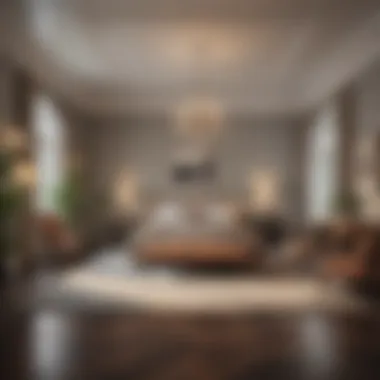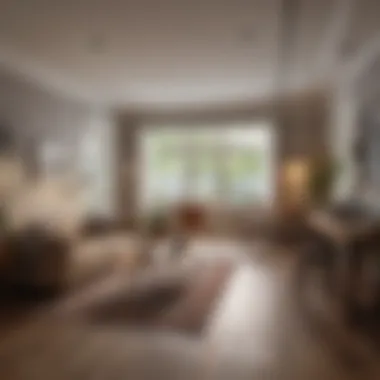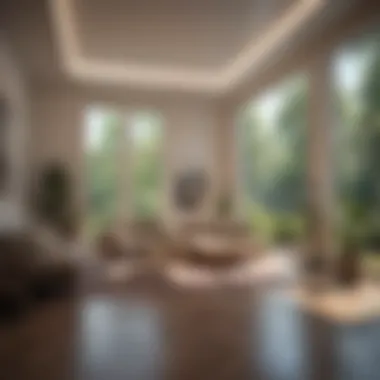Unveiling the Impact of Square Footage in Real Estate and Home Design on Property Valuation, Layout, and Living Experience


Inspiring Homes
Square footage plays a pivotal role in shaping the layout and functionality of luxury properties worldwide. From extravagant mansions in exclusive neighborhoods to sprawling villas overlooking scenic landscapes, the importance of square feet in real estate design cannot be overstated. These upscale residences often boast vast living areas, multiple bedrooms, lavish amenities, and meticulously landscaped grounds, all meticulously planned to maximize space and offer unparalleled comfort.
In contrast, cozy retreats like charming cottages and rustic cabins showcase a different facet of square footage's significance. These smaller yet well-designed homes prioritize coziness and intimacy, demonstrating how efficient use of space can create inviting living environments. Compact layouts, clever storage solutions, and personalized touches define these retreats, highlighting that square feet are not just about size but also about creating a welcoming and comforting atmosphere.
Stunning Locations
When exploring the impact of square feet in real estate and home design, one must consider the context of stunning locations where properties are situated. Exotic destinations with limited land availability often see intricate design strategies to optimize every square foot effectively. The juxtaposition of luxury and constrained space challenges architects to innovate and create awe-inspiring residences blending seamlessly with their tropical or remote surroundings.
In bustling cityscapes, the importance of square feet takes on a different dimension. Urban properties, from modern high-rises to historic brownstones, showcase how efficient utilization of space is critical in densely populated areas. Buyers value well-designed interiors that maximize every square foot, offering functionality without sacrificing style. In these vibrant urban centers, luxury living is often synonymous with clever space planning and multi-functional areas.
Interior Design Trends
The connection between square feet and interior design trends is profound, influencing everything from home decor ideas to furniture selection. Homeowners seeking inspiration for stylish interiors often turn to color palettes to set the mood for each room. The impact of square footage on color choice is evident, as lighter hues can amplify the sense of space in smaller areas, while darker tones add richness and warmth to larger rooms.
When it comes to furniture selection, the significance of square feet cannot be understated. Smaller living spaces demand versatile pieces that optimize functionality without overcrowding, leading to a growing trend in modular and space-saving furniture design. Understanding the relationship between square footage and furniture scale is essential in creating visually appealing and practical interiors that harmonize with the overall layout of a home.
Travel Guides
From must-visit destinations to off-the-beaten-path gems, understanding square feet's impact on travel accommodations provides valuable insight for explorers and vacationers alike. In destination guides, travelers can uncover how different accommodations leverage space to enhance the guest experience. Whether it's maximizing square footage in luxury suites or optimizing layouts for cozy boutique stays, the connection between spatial design and travel comfort is evident.
Travel tips that explore the nuances of square feet in various accommodation types offer practical advice for travelers seeking memorable and efficient stays. Insider recommendations on room selection based on square footage, amenities that add value to limited space, and spatial organization tips all contribute to a seamless and enjoyable travel experience, shaping travelers' perceptions of comfort and convenience.
Real Estate Market Insights
In the realm of real estate market insights, square footage is a key metric that influences property valuation, investment decisions, and buyer preferences. Market trends analysis often delves into how square footage impacts pricing, with larger properties commanding higher values based on their total square feet. Forecasting trends in square footage preferences can provide valuable insights for investors seeking properties with strong appreciation potential based on size and spatial layout.
For those considering real estate investments, understanding square feet's role in different property types is crucial for evaluating potential ROI. Factors such as price per square foot, resale value based on total area, and rental income projections all hinge on square footage considerations. Buying guides that emphasize the significance of square feet offer prospective buyers a comprehensive understanding of how size influences investment decisions and long-term property value.
Introduction to Square Feet
In the realm of real estate and home design, the concept of square feet holds pivotal significance. Square feet serve as a foundational metric, influencing property valuation, interior layout, and the overall living experience. It acts as a fundamental unit of measurement that dictates the functionality and aesthetics of a living space. Understanding the nuances of square feet is paramount for individuals involved in buying, selling, or designing properties. By navigating through the intricacies of square footage, one can grasp its far-reaching implications on the housing market and lifestyle choices.
Defining Square Feet


Measurement Unit
Delving into the concept of square feet, the measurement unit plays a vital role in quantifying the spatial dimensions of a property accurately. Square feet provide a standardized method for calculating the area enclosed within a space, ensuring precise estimations for real estate purposes. This unit is widely recognized and accepted in the industry due to its simplicity and ease of comprehension. The ubiquitous nature of square feet as a measurement unit streamlines communication and facilitates seamless transactions within the real estate sector. Despite its simplicity, square feet offer a comprehensive evaluation of spatial requirements, guiding property developers and homeowners in optimizing living spaces efficiently.
Square Footage Calculation
The process of square footage calculation involves intricate measurements and calculations to determine the total area of a property accurately. By multiplying the length and width of a space, one can derive the square footage, crucial for pricing, layout, and zoning regulations. Square footage calculation eliminates ambiguity in property dimensions, providing clarity for buyers, sellers, and designers alike. This methodical approach ensures transparency in property evaluations and facilitates informed decision-making in real estate transactions. While the precision of square footage calculation enhances the reliability of property information, it also sets a standard for assessing the value and utility of living spaces effectively.
The Influence of Square Feet on Property Value
In the realm of real estate and home design, the square footage of a property plays a pivotal role in determining its overall value. Square feet not only have a significant impact on property valuation but also influence various aspects of pricing strategies. Understanding how square footage affects property value is essential for both buyers and sellers alike as it directly translates into financial considerations when buying or selling a home. This section will delve deep into the relevance of square feet in the context of property valuation and pricing.
Impact on Pricing
When it comes to the impact of square feet on pricing, two crucial elements come into play - square footage trends and financial implications.
Square footage trends
Square footage trends refer to the prevalent patterns in property sizes that are desired or favored by homebuyers. These trends can vary over time and are influenced by factors such as market demand, architectural styles, and lifestyle preferences. Understanding these trends is vital for real estate professionals and homeowners looking to maximize the value of their properties. By aligning the square footage of a property with current trends, sellers can attract more potential buyers, leading to competitive pricing and faster sales. However, it's essential to note that following trends blindly without considering other factors like location and amenities may not always yield the desired results.
Financial implications
The financial implications of square footage are multifaceted and extend beyond just the initial purchase price. Larger square footage generally commands a higher selling price, but it also comes with increased costs for maintenance, utilities, and property taxes. On the other hand, smaller square footage may be more affordable upfront but could limit potential resale value in the future. It's crucial for buyers to evaluate the financial implications of square footage based on their long-term goals and budget constraints. Moreover, factors like the cost per square foot and the overall return on investment should be carefully considered to make informed decisions when purchasing or selling a property.
Square Feet in Interior Design
Square feet play a pivotal role in the realm of interior design, directly influencing how spaces are utilized and experienced within a home. In this article, we will explore the intricate relationship between square feet and interior design, shedding light on key considerations, benefits, and elements that shape living spaces. Understanding the significance of square feet in interior design is crucial for creating functional and aesthetically pleasing environments that cater to the modern homeowner's needs.
Space Optimization
Furniture Arrangement
Furniture arrangement is a fundamental aspect of interior design that revolves around optimizing the layout of furniture within a given space. The arrangement of furniture not only impacts the flow and functionality of a room but also contributes significantly to the overall aesthetics of the space. In this article, we delve into the key characteristics of furniture arrangement, emphasizing the importance of strategic placement to maximize square footage effectively. By focusing on creating balance, visual appeal, and functionality, furniture arrangement emerges as a popular choice for enhancing the overall design and functionality of interiors. Furthermore, we analyze the unique feature of furniture arrangement in its ability to transform a space by creating different zones that serve specific purposes, highlighting both its advantages and potential limitations within the context of square feet optimization (250-300 words).
Storage Solutions
Another critical component of space optimization in interior design is the implementation of efficient storage solutions. Storage plays a crucial role in maximizing square footage by ensuring that every inch of space is utilized effectively. In this article, we shed light on the key characteristic of storage solutions, underscoring their significance in decluttering and organizing living spaces. By exploring innovative storage solutions such as built-in cabinets, multifunctional furniture, and creative shelving units, we highlight why they are a popular choice for enhancing the functionality and aesthetics of interiors within the context of square feet utilization. Additionally, we discuss the unique feature of storage solutions in their ability to offer hidden storage options that seamlessly blend with the overall design, detailing their advantages and potential drawbacks to provide a comprehensive understanding of their role in optimizing square footage (250-300 words).


Functional Aspects of Square Feet
In delving into the realm of real estate and home design, the functional aspects of square feet play a pivotal role. Square footage serves as a foundational element in determining the layout and usability of living spaces. Understanding the functional aspects of square feet is essential for optimizing room allocation, ensuring spaces are both practical and aesthetically pleasing. By focusing on the specific elements, benefits, and considerations of functional aspects related to square feet, individuals can make informed decisions when it comes to property valuation and interior design.
Room Allocation
Bedrooms
Within the context of square footage, bedrooms hold significant importance. The allocation of square feet to bedrooms influences the overall functionality and comfort of a living space. Bedrooms are essential components that provide occupants with a private sanctuary for rest and relaxation. The key characteristic of bedrooms lies in their ability to offer individuals a space for personal retreat, promoting well-being and peaceful slumber. Choosing the optimal square footage for bedrooms is crucial, as it directly impacts the quality of life within a home. While larger bedrooms may offer more space for furniture and customization, smaller bedrooms can foster a cozy and intimate atmosphere. Understanding the unique features of bedrooms and their advantages or disadvantages allows homeowners to tailor their living spaces to meet their specific needs and preferences effectively.
Bathrooms
In the realm of square feet considerations, bathrooms hold a notable position. The allocation of square footage to bathrooms is critical for ensuring functional and comfortable amenities within a home. Bathrooms serve as essential areas for personal hygiene and relaxation, contributing significantly to the overall appeal and functionality of a property. The key characteristic of bathrooms lies in their ability to provide individuals with a space for rejuvenation and self-care. Choosing the appropriate square footage for bathrooms involves striking a balance between functionality and aesthetics. Larger bathrooms may offer luxurious features and ample space for movement, while smaller bathrooms can efficiently utilize square footage for practical purposes. Understanding the unique features of bathrooms and their advantages or disadvantages enables homeowners to create well-designed and efficient spaces that cater to their lifestyle needs.
Living Areas
When discussing square feet in interior design, living areas hold an essential role. The allocation of square footage to living areas profoundly impacts the social and functional dynamics of a home. Living areas serve as communal spaces for relaxation, entertainment, and socializing, contributing to the overall livability and appeal of a property. The key characteristic of living areas lies in their versatility and adaptability to various activities and uses. Choosing the ideal square footage for living areas involves considering factors such as available space, furniture arrangements, and traffic flow. Larger living areas may offer more room for entertaining guests and hosting gatherings, while smaller living areas can promote coziness and intimacy. Understanding the unique features of living areas and their advantages or disadvantages empowers homeowners to design welcoming and functional spaces that mirror their lifestyle and preferences effectively.
Aesthetics and Square Footage
Within the intricate tapestry of real estate and home design, the interplay between aesthetics and square footage occupies a central role. Aesthetic appeal plays a crucial part in the overall ambiance of a living space, influencing the perception of size and functionality. The careful integration of square footage considerations with aesthetic principles can yield visually stunning interiors that maximize both space and beauty. By delicately balancing the mathematical precision of square footage with the creative flair of aesthetics, homeowners and designers can create harmonious living environments that resonate with style and practicality.
Visual Impact
Open-concept design:
In the realm of interior design, open-concept design stands out as a cornerstone of modern living spaces. This layout approach entails removing walls and barriers to create a seamless flow between different areas of the home, promoting a sense of unity and spaciousness. Open-concept design embraces a fluidity that enhances social interaction and facilitates natural light penetration, resulting in an expansive and airy environment that feels inviting and connected. Its ability to merge kitchen, dining, and living areas cohesively cultivates a versatile space well-suited for both everyday living and entertaining. While open-concept design fosters a sense of togetherness and flexibility, some challenges such as noise transmission and limited privacy may arise, necessitating strategic furniture placement and acoustical solutions.
Natural light integration:
An essential element in interior aesthetics, natural light integration holds significant sway over the visual appeal and atmosphere of a living space. Harnessing natural light through strategic window placement, skylights, and light wells can transform a room, infusing it with warmth, brightness, and a connection to the outdoors. The infiltration of natural light not only illuminates the interiors but also creates dynamic shadows and highlights that enhance architectural features and decor elements. Natural light integration is revered for its ability to reduce energy consumption, uplift mood, and blur the boundary between indoor and outdoor realms, fostering a harmonious relationship with nature. However, challenges such as glare and uneven lighting distribution may necessitate the use of window treatments and light control strategies to optimize comfort and visual balance.
Maximizing Small Square Footage
When it comes to home design, particularly in urban settings where space is a premium commodity, the concept of maximizing small square footage becomes paramount. This section delves into the significance of efficiently utilizing limited space to create functional and visually appealing living environments. Through strategic planning and innovative solutions, homeowners can transform compact areas into stylish and practical spaces that fulfill their needs while optimizing every square foot available.


Space-enhancing Techniques
Multi-functional Furniture
In the realm of interior design, multi-functional furniture stands out as a practical and space-saving solution for maximizing small square footage. These versatile pieces serve dual purposes, such as a sofa bed or a storage ottoman, enabling homeowners to make the most out of limited space. The key characteristic of multi-functional furniture lies in its versatility, providing functionality without compromising on style. Despite its compact nature, multi-functional furniture offers additional storage or seating options, making it a popular choice for those looking to optimize their living areas efficiently. Although it may come with limitations in terms of design variety or customization, the advantages of multi-functional furniture in small square footage scenarios outweigh any potential drawbacks.
Illusion of Space
Creating the illusion of space is another crucial aspect of maximizing small square footage. This technique involves employing visual tricks and techniques to make a room feel more expansive than its actual dimensions. By using light colors, strategic lighting placements, and reflective surfaces, homeowners can enhance the perceived size of a room, making it appear larger and airier. The key characteristic of the illusion of space lies in its ability to fool the eye and create a sense of openness within confined areas. While this method may require careful planning and attention to detail, its advantages in maximizing small square footage are evident in the way it can transform cramped spaces into inviting and comfortable living areas.
Square Feet and Lifestyle Choices
In the realm of real estate and home design, the relevance of square feet extends beyond mere measurements; it influences lifestyle choices significantly. When considering the impact of square footage on lifestyle choices, one must navigate a landscape defined by contrasting preferences and needs. Urban versus rural living stands as a pivotal decision influenced by available space and community dynamics, shaping one's daily experiences and interactions.
Urban vs. Rural Living
Space Considerations
Within the context of square feet and lifestyle choices, space considerations play a crucial role in dictating the allure of urban or rural living. Urban spaces often offer compact living arrangements characterized by high-rise buildings and condensed layouts. On the other hand, rural settings provide more expansive land parcels, allowing for larger homes and outdoor amenities. The appeal of space considerations lies in the freedom to personalize living environments and create distinct atmospheres tailored to individual tastes.
Community Factors
The interplay between square feet and lifestyle choices is further accentuated by community factors, influencing the decision between urban and rural living. Urban environments foster a sense of connectivity through proximity to various amenities, cultural hubs, and diverse populations. In contrast, rural communities prioritize tranquility, nature-centric living, and tight-knit communal bonds. Understanding the nuances of community factors is essential in choosing a living environment that aligns with personal values, social preferences, and long-term aspirations.
Future Trends in Square Footage Preferences
Future Trends in Square Footage Preferences play a pivotal role in shaping the real estate landscape and home design practices. As society evolves, so do the preferences and demands of individuals seeking living spaces. Understanding these emerging trends is crucial for property developers, interior designers, and homeowners looking to stay ahead in the market. The future of square footage preferences is influenced by a range of factors, including environmental concerns, technological advancements, and changing social dynamics. By exploring these trends, we can better comprehend how living spaces will adapt to meet the needs of occupants in the years to come.
Shifts in Buyer Demands
In the realm of real estate and home design, the preferences of buyers are constantly evolving, steering the industry towards new innovations and practices. Two prominent aspects shaping these shifts are sustainability concerns and technology integration. - Sustainability concerns: Sustainable living has gained considerable traction in recent years, with more individuals opting for eco-friendly and energy-efficient homes. The emphasis on sustainability lies in reducing environmental impact, conserving resources, and creating healthier living environments. Homes designed with sustainability in mind often feature green technologies, environmentally friendly materials, and energy-saving fixtures. The integration of sustainable practices not only benefits the planet but also enhances the overall quality of living spaces. - Technology integration: The integration of technology has revolutionized the concept of modern homes, introducing smart features that optimize convenience, security, and efficiency. From smart home automation systems to energy management tools, technology integration enhances the functionality and comfort of living spaces. The incorporation of tech-savvy solutions offers residents greater control over their environments, promoting connectivity and ease of living. While technology integration enhances the living experience, considerations regarding data security, maintenance, and compatibility should also be factored in to ensure seamless operation and longevity.
Conclusion
Summarizing Square Feet Significance
Essential role in property
Exploring the essential role of square feet in property design and evaluation reveals its fundamental contribution to the overall appeal and utility of a space. Square footage serves as a key determinant in pricing properties accurately and assessing their financial worth. Its pivotal role extends to space allocation within properties, ensuring optimal functionality and comfort for occupants. The crucial characteristic of square feet lies in its ability to provide a quantitative measure of usable space within a property, aiding buyers in their decision-making process. While larger square footage is often preferred for spacious and flexible living environments, smaller square footage can present cost-effective alternatives with efficient space utilization.
Aesthetic and functional impacts
Delving into the aesthetic and functional impacts of square feet underscores its significant contribution to the visual appeal and usability of living spaces. The square footage of a property directly influences the design possibilities, furniture arrangements, and overall ambiance of a room. Optimal utilization of square feet can create visually appealing spaces with efficient traffic flow and comfortable living quarters. The unique feature of square feet lies in its ability to balance aesthetics with functionality, providing homeowners with versatile design options to suit their preferences. While larger square footage offers more design flexibility and room for creativity, smaller square footage challenges occupants to optimize space through innovative design solutions.



